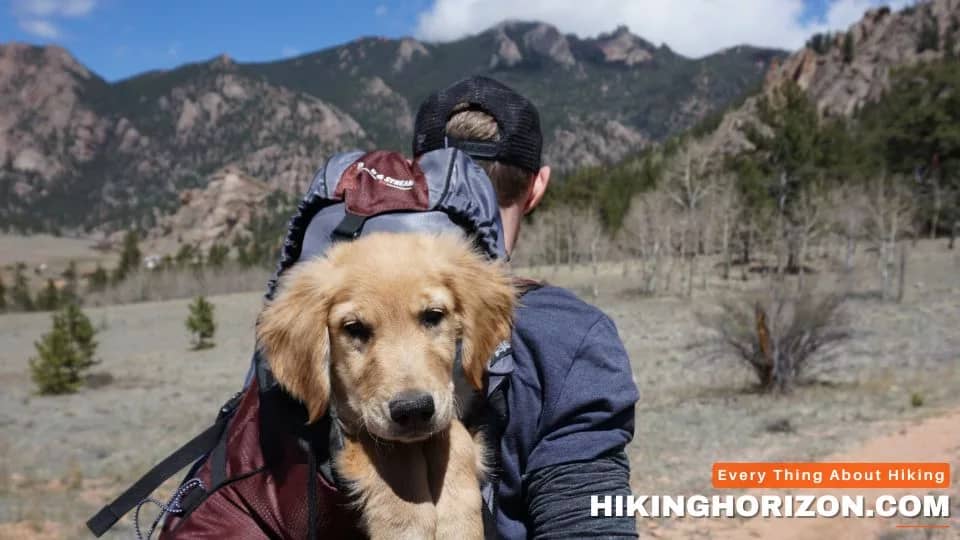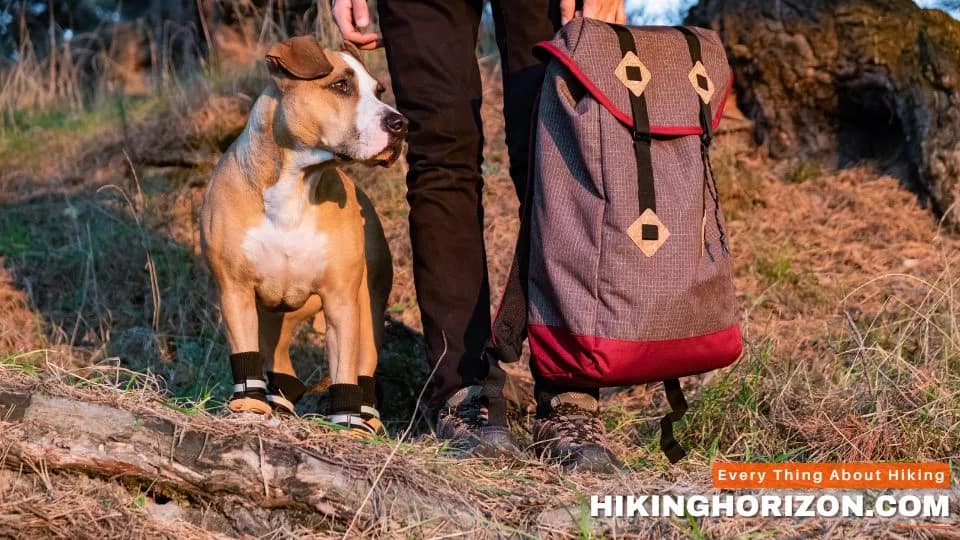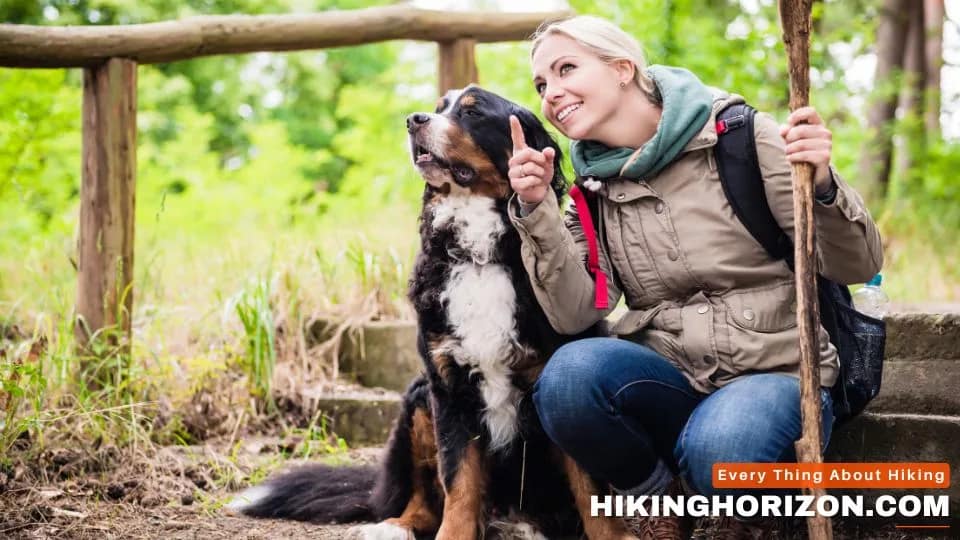
Hiking is one of the best outdoor activities to enjoy with your furry companion. Getting out on the trails together is great exercise, helps strengthen your bond, and allows your dog to explore nature. However, many trails are too long or difficult for dogs to hike entirely on their own four paws.
This is where carrying your dog in a specialized hiking backpack comes in handy! Bringing your dog along in a comfortable backpack allows you to go farther and tackle more challenging terrain without overexerting your pup.
This complete guide will cover everything you need to know about safely and enjoyably Hiking With Dog In Backpack.
Key takeaway:
- Choose dog-friendly trails
- Use a proper dog backpack and leash
- Condition dog gradually
- Bring essential dog gear (food, water, first aid)
- Take regular breaks
- Watch for injury/overexertion
- Protect paws on rough terrain
- Follow trail etiquette (pick up waste, leash around others)
- Beware of wildlife, plants, insects, hazardous water
- Know your dog’s limits
- Ensure training/personality suits backpacking
- Start short and easy, then build up distance/difficulty
Table of Contents
Factors to Consider Before backpacking with a dog

While carrying your dog on a hike can be very rewarding, there are important factors to consider beforehand:
Visit A Vet
Consulting your vet should be high on your to-do list before packing up and heading for a nature-filled adventure with your furry friend. They’ll help answer several key questions that will ensure your dog is physically and immunologically prepared for the trip:
Is Your Pooch Physically Prepared?
- Ensuring your young dog is strong enough for an outdoor excursion is important. You might be surprised to find out that their bones aren’t fully mature until they’re around one year old, give or take a few months, depending on size and breed. Only after they’ve reached this physical milestone should you consider taking them for vigorous outdoor adventures.
Vaccinations and Preventive Medications
- In an urban environment, you may not stress about your dog contracting diseases like leptospirosis or giardiasis, which they can pick up from drinking contaminated water. However, when going camping or hiking, these become a real concern. Chat with your vet about any necessary vaccinations or preventive treatments that might be specific to your chosen destination’s potential hazards.
Is Your Dog’s Immune System Ready for the Outdoors?
- Your dog’s vaccine schedule and natural immunity development pace are significant factors in determining whether they’re ready to face the wild. Your vet may provide advice centered on the optimal age for your dog to embark on a wilderness trip, ensuring it aligns with these factors and ensures your pet’s safety.
Your Dog’s Temperament
Ensure your dog has the right temperament to handle being in a backpack for an extended hike. Anxious, skittish, or easily-stressed dogs likely won’t do well confined.
Practice first with short trips. Ensure your dog is comfortable and confined and can settle in.
Your Dog’s Size and Health
Only carry healthy dogs who fall within the size limits of your backpack carrier. Standard backpacks support dogs up to 15-25 lbs.
Larger or elderly dogs with medical issues will likely be uncomfortable or unsafe to carry. Consult your vet on any health concerns.
Weather Conditions
Factor the forecasted temperature, humidity, sun exposure, and access to shade and water. Your dog can overheat in warm weather.
Avoid hiking on extremely hot days. Take more breaks in the shade if needed. Cold weather may require a dog jacket.
Trail Difficulty
Assess if the trail terrain and length work for your and your dog’s fitness levels. Don’t push too hard.
Be realistic about distance based on your pace and stamina carrying extra weight. Save overly challenging hikes for when you can leave your dog at home.
Backpack Weight Distribution
Test different weights in the backpack to find the right balance and positioning that is comfortable for you.
You will be carrying all your own gear plus the added pounds of your dog for an extended period. Don’t overload yourself.
| Factor | Details |
|---|---|
| Vet Consultation | Check fitness level, vaccinations needed, age appropriateness |
| Dog Size | Use proper fitting backpack for dog’s weight and measurements |
| Dog Temperament | Ensure dog can handle confinement of backpack |
| Weather | Assess temperature, sun exposure, shade/water access |
| Trail Difficulty | Match to you and dog’s fitness and experience |
| Gear Weight | Limit pack weight to 10-25% of dog’s body weight |
Choosing the Best Dog Backpack Carrier

Choosing the right backpack carrier is the most important gear for hiking with your dog. Key features to look for include:
Proper Sizing and Fit
Look for a backpack made for your dog’s weight and body measurements. They should fit snugly and securely without restricting movement.
Fitting your Dog’s Pack
To equip your beloved pet with a snug-fitting pack, determine the measurement around the broadest part of the rib cage – the chest circumference. Interestingly, the majority of available packs will indicate sizes that match this measurement.
Ensuring an Optimal Fit
Modulate the pack’s straps carefully until it fits just right. The key here is to strike a balance between a secure fit that doesn’t constrain the dog’s breathing and avoiding a loose fit that could rub and cause discomfort or even worse, slip off.
Rules about Pack Weight
Whilst for humans, the rule of thumb is to carry a backpack weight not exceeding 20-25% of our body weight, the same may not necessarily apply to our canine friends. Factors such as their age, size, strength, and other unique characteristics will influence this percentage. Therefore, a consultation with your vet to establish a suitable weight limit would be a prudent step to take. A hint of caution here, though – remember that the wellbeing of your beloved pet, rather than carrying as much weight as possible, should be the primary focus.
Measure your dog’s length, chest width, and weight. Consult sizing charts to find the ideal bag.
Breathable Material and Ventilation
Proper ventilation prevents your dog from overheating. Look for backpacks made of breathable mesh material, especially on sides.
Vents along the back and sides allow airflow. Some bags also come with built-in solar fans for added circulation.
Padded Straps and Supports
Padded shoulder straps, chest straps, and waist straps distribute weight and increase carrying comfort on long hikes.
Lumbar support helps reduce strain on your back. Sternum straps stabilize the load.
Durable Fabric and Construction
Look for tough, rip-resistant nylon or polyester fabric that can withstand the wilderness. Durable stitching and reinforced seams add longevity.
Water-resistant material protects your pup from rain or mud while out on the trail.
Attachment Points for Gear
Convenient external hooks and pockets allow you to attach hiking essentials like water bottles, snacks, small packs, walking sticks, etc.
Easy access to gear keeps necessities close at hand when you want them.
Reflective Accents and Colors
Choose a bag with reflective stripes and bright colors for hiking near roadways or in low light for visibility.
Reflective accents help keep you and your dog safer in the dawn, dusk, or night hiking conditions.
Escape Hatch/Leash Clip
A sturdy D-ring securely attaches your dog’s leash to their backpack. This allows them to safely exit the carrier when stopped.
An escape hatch also allows easy access in and out at your breaks. Close securely for carrying.
Viewing Windows
Mesh windows on the sides or top allows you to monitor your dog inside and ensure they’re doing okay.
Windows also give your dog a view of the passing scenery without fully exiting the backpack.
Getting Your Dog Comfortable Before Your Hike

Don’t just put your dog in a pack and head out! Take time at home first to get them used to this new experience:
Get your dog used to the Empty Doggy backpack
Place the open backpack on the floor and let your dog approach and sniff it thoroughly first. Allow them to climb in and out at their own pace so they know it’s not scary.
Toss treats inside so they associate the bag with a positive experience.
Give your dog Short Practice Walks
Once your dog willingly enters the bag, lift it a few inches off the ground and take a few steps. Praise and reward.
Slowly increase distance and walk around inside and outside. Let them back out immediately if they seem uneasy.
Put the Bag On
Next, with your dog in the bag, actually put the pack on. Walk very short distances and get them used to the feeling of motion. Reward calm behavior, then let them out.
Gradually work up to longer in-bag periods. Keep it positive.
Get Them Used to Gear Straps
Attach any straps or gear you’ll have on hikes to acclimate your dog to the feeling. Shake treats to keep them focused on rewards rather than any restrictive sensations.
Don’t Rush!
Take it slow and make sessions positive. Rushing the process can cause fear. Advance to the next step only when your dog is fully comfortable with the current one.
With consistency and praise, your dog will be backpack-ready in no time. Patience prevents problems.
Packing Essentials for Your Dog Hiking Backpack

In addition to your own hiking supplies, make sure to pack the following dog-specific items:
- Collar with ID tags
- Sturdy leash and harness
- Portable water bowl
- Dog food/treats
- Waste bags for cleanup
- Towel or blanket
- First aid kit (pads, tick remover, wound wash)
- Cooling mat (for rest breaks)
- Dog jacket or booties (in cold weather)
Stash supplies in the backpack’s compartments or attach to clips externally. Carry more water than you think you’ll need to prevent dehydration.
Reassess as the weather changes. In winter, opt for warmer and waterproof gear to keep your dog cozy. In summer, focus on cooling supplies.
| Essential Gear | Details |
|---|---|
| Collar/ID tags | Identification and emergency contact info |
| Leash and harness | For control on the trail |
| Portable water bowl | For water breaks along hike |
| Dog food and treats | Meals and motivation |
| Waste bags | For cleanup along trail |
| Towel or blanket | For rest breaks and post-hike |
| First aid kit | Tend to dog’s minor injuries |
| Cooling gear | Prevent overheating (vest, mat, etc) |
| Weather gear | Protection from elements (jacket, booties) |
Trail Etiquette for backpacking With Dogs
To be polite trail companions, follow proper etiquette when hiking with your dog:
Leash Your Dog Near Others
Keep your dog leashed when passing other hikers. Not everyone loves dogs, so leashing avoids nuisances or unwanted interactions.
Scoop All Poop
Pack out all dog waste bags – no one wants to step in a surprise! Dispose properly at trailheads.
Don’t Allow Excessive Barking
Loud or constant barking can disturb wildlife and other hikers. Refocus their attention or provide quiet treats if barking excessively.
Respect On-Leash Rules
Obey any trailhead leash regulations. Just because your dog rides in a pack doesn’t make it off-limits. Be responsible.
Don’t Let Your Dog Approach Others
Ask permission before allowing your dog to approach strangers or other dogs. Not all are friendly.
Be Considerate at Rest Stops
Keep your dog from invading the space of other resting hikers. Maintain distance and don’t block paths.
Proper etiquette makes the hike enjoyable for everyone. You represent all dog owners out there!
How Much Weight is Recommended for Dog Carry Backpacking?
Determining how much weight a medium-sized dog can safely carry in a backpack while backpacking depends on several factors. When planning a backpacking trip with your dog, keep these guidelines in mind:
- The general rule is a healthy dog can carry up to 25% of their body weight in a backpack. However, this varies by breed and individual dog.
- Start conservative – a medium-sized dog’s pack should not exceed 10% of their weight when first training with an empty backpack.
- Slowly build up conditioned weight in 5% increments on practice hikes. Monitor for signs of strain or discomfort.
- Giant breeds and young dogs should not carry over 15% of body weight, even when fully grown. Their developing joints are vulnerable.
- Consider your dog’s fitness level and trail experience. An athletic hiking dog can handle more weight than a couch potato.
- The weight your dog can carry depends on the terrain. Rough trails with lots of elevation change will require lighter loads.
- Even if your dog is physically able to carry a heavy load, they may not enjoy the experience. Know your dog’s personality and tolerance.
- Obese dogs should not backpack until reaching a healthy weight. The extra pounds strain their body. Consult your vet.
- Use a dog-specific backpack designed to distribute weight properly across their frame.
- Weigh your dog’s pack on a scale when loaded to confirm it is within their limits.
The best tip for safe backpacking with medium-sized dogs is to start conservatively until you know your dog’s comfortable capability. Keep an eye out for signs of soreness or fatigue. With practice and increasingly challenging hikes, your dog can discover how much they can happily carry on your wilderness adventures together.
Tips for Hiking Safely With Your Pup

Hiking with your pup requires extra planning and precaution. Follow these tips to hit the trail safely:
Evaluate the Trail Regulations
Ensuring you can bring your dog along on the trail is crucial. National Parks, housing a variety of sensitive ecosystems, have varying rules about where dogs are permitted. While some parks allow leashed dogs in specific areas, other parks completely ban dogs. Trails and wilderness areas often restrict dogs, and rules differ from park to park, even at the state and local level.
Incorporate Training Walks
Given your dog happily sprints around your house or walks with you around the neighborhood, it doesn’t necessarily mean they’re up for a long, challenging hike. Like humans, dogs also need to gradually build their endurance and acclimate to altitude changes. So, start by taking them on some shorter training walks and moderate day hikes, observing their behavior and reactions, especially in extreme temperatures. Make note of signs of exhaustion like heavy panting, drooling, glazed eyes, or lethargy.
Test Their Discipline
Your dog might flaunt impeccable discipline within the confines of your yard, but they might get distracted in the wild when a squirrel races past. So, be sure you know how your dog will react to commands in diverse environments.
Pre-Trial the Gear at Home
Your comfortable tent might intimidate your canine friend. Chances are, it’s a new, bizarre structure that they are not particularly thrilled to be in. Let your dog get accustomed to all the gear they will use during the hike. Erect your tent in your backyard or living room and let your pet inspect it. If your plan includes having your dog carry their own backpack, let them wear it at home first so they can get used to the sensation. Don’t forget, they should carry no more than 10% of their body weight.
Dog-Proof Your Equipment
This might not be the best time to use your lightweight camping gear. Your dog’s paws could unintentionally damage delicate material, so use sturdier gear instead. A great tip to protect your tent floor is to use two footprints—one under the tent as usual and one inside.
Safeguard Their Paws
Harsh trail surfaces like lava rock or shale could be too rough or uncomfortably hot for your dog’s unprotected paws. So, preparing your dog to wear protective booties might be a good idea. Start this practice well before your trip to ensure your dog isn’t uncomfortable.
Carry Extra Treats for Strangers
In case your dog is a tad uncertain about encountering fellow hikers, carrying some deliciously enticing treats is useful. Having hikers reward your dog with a treat can teach your dog that strangers on the trail are not a threat.
Leave no trace ─ Manage the Waste
Just as you wouldn’t leave trash on the trail, neither should your dog. As per the Leave No Trace principles, keep poop bags or bury your dog’s waste just as we do for humans. Safeguard the aesthetics of the trail for other hikers by responsibly dealing with your dog’s waste.
Keep Them Clean
Pack an extra towel for your pet, helping to wipe off the dirt and mud from their paws and belly post-hike. Dogs with longer coats could benefit from a brush and small scissors to remove any debris from their fur. Don’t forget a quick check for any thorns that might have lodged in your dog’s paws!
Protect Your Food
It’s not just wild animals you need to watch your food from, but your own pet too. Keep your foodstuff out of their reach to avoid unanticipated feasting.
Set Up a Camp Cable Line
When setting up for the night, create a cable line that provides your dog some roaming space without straying too far from the camp. All you need is a static line between two trees and a carabiner to attach your dog’s leash.
Make sure your dog gets a Comfort sleep
Just as you appreciate a good night’s sleep after a taxing day on the trail, so does your dog. Consider bringing an old foam sleeping pad cut to size for your pet’s comfort. Also, a familiar blanket or stuffed toy could help your pet adjust in a new environment.
Equip Yourself with Dog-Specific First Aid
And finally, have a first aid kit that caters to both you and your dog. Standard items like gauze or tweezers for tick removal are good to carry. Additionally, pack items like superglue for patching torn pads, EMT gel for wound healing, vet wrap, a dog-safe antihistamine for stings, and Gas-X for bloating. Remember to check with your vet for appropriate dosages. With careful planning, your dog can be a delightful addition to your backpacking adventure, ensuring companionship and a wealth of joyous moments on the trail.
What are the hazards while dog backpacking?
Bringing your furry friend hiking opens them up to new dangers. As their owner, it’s your job to protect them. Watch out for these common hazards to dogs on the trail:
Overexertion
Pay close attention to signs of fatigue like heavy panting, slowing pace, and reluctance to move forward. Dogs don’t know their limits – you must enforce breaks and shorten mileage when needed. Don’t let eagerness put their health at risk.
Ticks
Ticks carrying Lyme disease are prevalent on many trails. Check your dog thoroughly after each hike and properly remove any embedded ticks. Early treatment prevents long-term complications.
Wildlife
Carnivores like bears or coyotes can pose a threat. Keep your dog leashed and supervise them closely around wildlife. Avoid surprising encounters that could provoke aggressive defensive reactions.
Poisonous Plants
Learn to identify local flora like poison ivy, oak, and sumac. Also, watch for potentially toxic plants if your dog is prone to chewing greenery on the trail. Halt ingestion immediately if you spot it.
Foxtails
These sharp, barbed grass seed heads can become lodged in your dog’s paws, ears, eyes, nose, or genitals. Avoid foxtail-prone areas or check frequently for lodged foxtails, which can lead to serious infection if left untreated.
Heat Stroke
Dogs struggle to regulate temperature and can overheat faster than humans. Rest often in the shade, supply water, and pack a cooling vest or mat for when they appear overtired or overheated. End hiking early if concerned.
Hazardous Water
Lakes or streams can contain parasites, bacteria or toxins. Carry dog-safe purified water rather than letting them drink untreated water. Have them wear a doggie PFD if swimming ability is limited.
The trail may seem harmless to you, but it has many unseen hazards for your four-legged hiking buddy. Take preventative steps and watch closely for potential problems that could cut your hike short. With vigilance, you’ll both stay safe while exploring the great outdoors!
Frequently Asked Questions About Hiking With Dogs in Backpacks
Can you go backpacking with your dog?
Yes, you can absolutely go backpacking with dogs! Many trails allow dogs, making it possible to take your furry friend backpacking. Consider factors like your dog’s size, health, fitness level, and training before backpacking with a dog. Not all dogs may be suited for longer hikes with a backpack. Prepare properly and start small to see if your dog can handle backpacking.
How long can a dog stay in a backpack?
Most experts recommend letting your dog out of a doggy backpack to walk around every 45-60 minutes. Avoid keeping them confined in a backpack for extended periods. Take regular breaks on an overnight backpacking trip to let your dog stretch their legs, get water, and go to the bathroom. Know your dog’s limits and watch for soreness, anxiety, or overheating signs.
Is it hard to backpack with a dog?
Backpacking with a dog has challenges but is very doable with the right preparation! Bringing a dog inherently adds more gear and responsibility. Consider their food, water, first aid supplies, cleanup bags, etc. Practice first with short hikes and an empty backpack to get your dog used to wearing one. Pack weight limits vary by breed and size. A dog’s backpack should not exceed 10-25% of their body weight. Adjust your mileage based on your dog’s fitness level. With training and by starting small, backpacking with dogs can be very rewarding!
Are dog backpacks uncomfortable for dogs?
Properly fitted, high-quality dog backpacks designed for hiking should not be uncomfortable when used appropriately. Avoid overweight packs that restrict movement or chafe. Look for padded straps, ventilation, and weight distribution. Let your dog gradually get used to wearing a pack, first with no weight. Proper conditioning prevents discomfort. However, not all dogs tolerate a backpack well, so know your dog’s tolerance. Take breaks and watch for signs of irritation. Discontinue use if a dog shows distress with a backpack.
What to do with your dog when you go backpacking?
If your dog is not already conditioned to backpacking with you, consider these options when you go backpacking: leave them at home with a petsitter, board them at a kennel, or look into dog-friendly campgrounds nearby that allow shorter day hikes together. Until a dog builds fitness and trail experience, they may not be ready for multi-day excursions. Avoid overestimating their capabilities. Better to start small with your dog first before tackling serious backpacking trips.
Do dogs enjoy hiking?
Most dogs love hiking when adequately prepared for the trail! It provides mental stimulation, new smells, and bonding time with their owner. Ensure adequate fitness, conditioning, and training beforehand. Monitor your dog closely for signs of fatigue, sore paws, overheating, anxiety, etc. Adjust distance and difficulty to your dog’s capabilities. Proper hydration, nutrition, rest, first aid preparedness, and gear on the hike allow dogs to enjoy themselves safely. Reward and praise them during the hike to make it a positive experience they look forward to.
Do I need to pick up dog poop when hiking?
Absolutely! Always pack out dog waste bags and pick up all solid dog poop when hiking or backpacking. Most trails require owners to immediately remove and dispose of dog feces properly. No one wants to step in it or have it wash into water sources. Dog poop can spread harmful bacteria and parasites, so disposable bags are a must. Carry them and dispose of full bags at trailheads or designated waste receptacles. Leaving poop on trails is unsanitary, inconsiderate, and often illegal.
Where do you put dog poop when hiking?
Carry disposable plastic bags designed for dog poop pickup when hiking with your dog. After your dog defecates, use an inverted bag over your hand to scoop up the poop securely. Tie off the bag tightly and stash it in your backpack or attach it to your dog’s leash. Carry all solid dog waste out in bags until you reach a trash can at the trailhead or parking area. Never bury or leave dog poop on hiking trails. Take responsibility and pack it out properly. Proper removal protects the environment and shows respect for other hikers.
Conclusion: hiking with dog in backpack
Hitting the trail with your four-legged friend can be an amazing adventure when done right. But not every dog is cut out for backpacking’s demands. Consider their personality, conditioning and your own skills before attempting an overnight trip.
Test them first on day hikes of increasing length and difficulty. See if they take to wearing a doggy backpack and can follow commands even when excited or distracted. Monitor for signs of injury or anxiety.
And be considerate of others by always picking up dog poop and keeping your pup leashed and under control. With preparation and realistic expectations, you and your tail-wagging companion can enjoy happy hiking memories for years. The trails await!

SARAH LEE
Sarah has been hiking for over five years and is passionate about promoting the mental and emotional benefits of spending time in nature. She has written several articles on the topic and strongly advocates hiking as a form of therapy. Sarah is also a certified yoga instructor, often incorporating yoga and mindfulness practices into her hiking trips. She is dedicated to providing accurate and up-to-date information on trail conditions, difficulty levels, and must-see sights.

SARAH LEE
Sarah has been hiking for over five years and is passionate about promoting the mental and emotional benefits of spending time in nature. She has written several articles on the topic and strongly advocates hiking as a form of therapy. Sarah is also a certified yoga instructor, often incorporating yoga and mindfulness practices into her hiking trips. She is dedicated to providing accurate and up-to-date information on trail conditions, difficulty levels, and must-see sights.




There is definately a lot to find out about this subject. I like all the points you made
I can’t get enough of your insightful articles and engaging stories. Thank you for sharing your passion with the world!
I appreciate your creativity and the effort you put into every post. Keep up the great work!
The tips on choosing a proper backpack for a small dog and conditioning them gradually for the trail are quite insightful. This will allow me to enjoy the outdoors more with my pup while keeping their wellbeing priority number one. Useful advice!
As a fellow outdoor enthusiast with a precious pup in tow, I loved this informative guide on bringing your small dog along safely in a carrier backpack. The tips on choosing a pack with proper weight distribution, ventilation, comfort and security are so valuable before taking your furry friend out on the trails. And emphasizing gradual conditioning hikes is brilliant advice to avoid overexerting a dog’s body. My little corgi Lucy will be far more comfortable carried in a quality pack designed just for tiny pups rather than hastily stuffed in my normal hiking bag!
I’ll certainly try the recommended ground training exercises as well so Lucy better understands the new experience of riding “shotgun” during our adventures. Thanks so much for this thoughtful content that covers both the bonding joys and responsible precautions of hiking with dogs. Now Lucy and I can’t wait to hit the trails together for some beautiful vistas and quality snuggle time!
Thank you Steavee!!
I highly appreciate your lovley comment.
Hi my friend! I want to say that this post is awesome nice written and come with approximately all significant infos I would like to peer extra posts like this